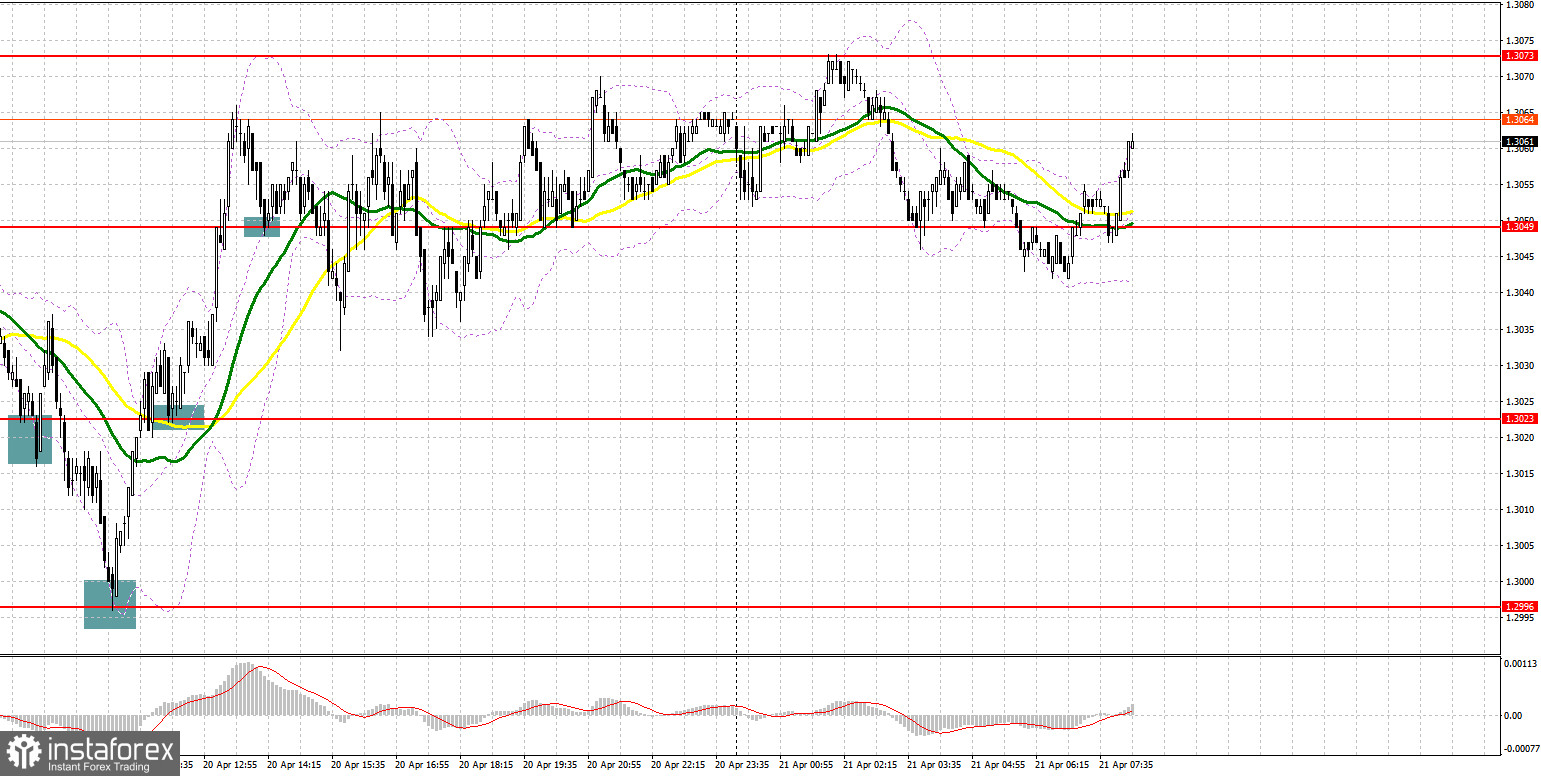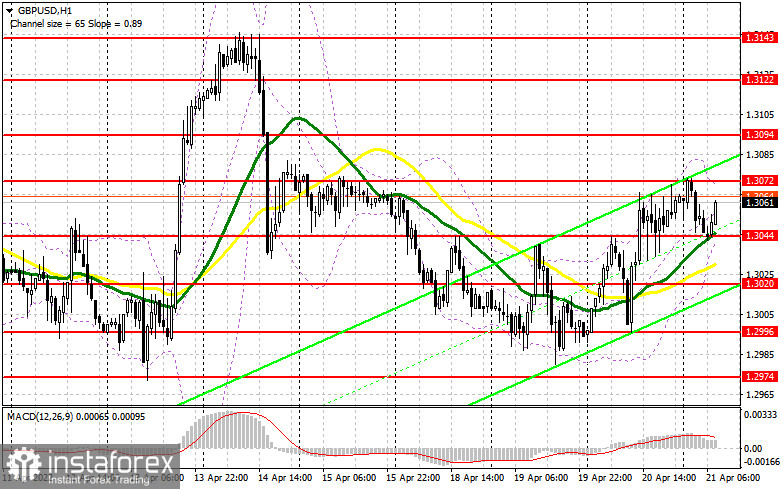Yesterday, quite a lot of market entry signals were formed, which made it possible to earn. Let's take a look at the 5-minute chart and see what happened. In my morning forecast, I paid attention to the levels of 1.3023 and 1.2996 and advised you to make decisions on entering the market. A false breakout at 1.3023 at the beginning of the European session led to a signal to buy the pound, but as we can see, it did not significantly rise. As a result, the pound collapsed, which led to consolidating losses. But it didn't end there: a false breakout at 1.2996 led to another signal to buy the pound, and after some time the bulls were already going back above 1.3023, which allowed them to take about 30 points from the market. A test of 1.3023 from top to bottom was a confirmation of another entry point, which subsequently brought more than 40 points of profit. In the afternoon, a reverse test of 1.3049 and the formation of a false breakout there had made it possible for us to enter the market in long positions again, however, after moving up by 10 points, the pressure on the pound returned. There were no other convenient entry points formed, as the main trading was carried out around the level of 1.3049.

To open long positions on GBP/USD, you need:
The pound broke through to the next weekly highs, but the pair's upward potential is clearly limited. In the absence of serious fundamental statistics on the UK, a lot will depend on the statements of Bank of England Governor Andrew Bailey, who will deliver a speech this afternoon. If there is a more hawkish approach to monetary policy in his words, most likely the pound will continue to be in demand and it is quite possible that we will see a slight upward push in the pair. However, it is unlikely that everything that happens in the world and the UK economy will allow bullish potential to be maintained for a long time. Bears will take advantage of the moment and attractive prices, and again begin to be more active. As I said, today there are no statistics on the UK, which is undoubtedly a good thing for pound bulls, who are counting on the pair's growth during the European session. For this reason, the bulls have every chance of maintaining the nearest support at 1.3044, where the moving averages are passing, playing on their side. You can count on buying from this level only after a false breakout. If there are no people who want to buy the pound there, I advise you not to force things, and postpone entering the market until a larger support of 1.302 and only when a false breakout is formed there. If the bulls are not active there - the best scenario would be long positions for a rebound from 1.2996, or from the monthly low - 1.2974, based on an upward correction of 25-30 points within the day. An equally important task for today is to grow and consolidate above the resistance of 1.3072, the test of which we observed during the Asian session. Only a breakthrough and reverse test of this level from top to bottom will provide a signal for long positions as we count on restoring the pound to the area of 1.3094. This will be enough to reverse the downward trend in the pound and build an upward correction in the pair. A breakthrough of 1.3094 will open a direct road to 1.3122 and 1.3143, where I recommend taking profits.
To open short positions on GBP/USD, you need:
This morning the bears defended the resistance at 1.3072, but so far this is not enough to complete the upward correction. Only the repeated formation of a false breakout at this level in the first half of the day will lead to a signal to open short positions, counting on the resumption of the bearish trend. With the pound being under pressure following Bailey's statements, the bears will have to work very hard to achieve consolidation below 1.3044. If this can be done, most likely the bulls will begin to quickly leave the market, and the removal of a number of stops below this level will surely strengthen the bear market, which will lead to an update of the next support at 1.3020. A breakthrough and reverse test from the bottom up of this level will provide another signal to open short positions with an exit to 1.2996. The 1.2974 level will be the next target, where I recommend taking profits. In case GBP/USD grows and there is a lack of activity around 1.3072, the bulls will continue to push the pair up. In this case, I advise you to postpone short positions until the next major resistance at 1.3094. I also advise you to open short positions there only in case of a false breakout. It is possible to sell GBP/USD immediately for a rebound from the high of 1.3122, counting on the pair's rebound down by 30-35 points within the day.

I recommend for review:
The Commitment of Traders (COT) report for April 12 logged an increase in short positions and a reduction in long ones. All this once again confirmed the attitude of traders to the British economy, which is teetering on the brink of recession mixed with the highest inflation for a long period of time. The sharp rise in the consumer price index in March this year to another high of 7.0% once again proved the complexity of the situation in which the Bank of England (BoE) found itself, but the report on UK GDP, on the contrary, did not please traders much. The situation will only worsen, as future inflation risks are now quite difficult to assess due to the difficult geopolitical situation, but it is clear that the consumer price index will continue to grow in the coming months. At the same time, the soft position of the governor of BoE will push prices up. The pressure on the pound is also increasing due to the aggressive policy of the Federal Reserve, which is becoming more hawkish every day. In the US, there are no such problems with the economy as in the UK, so there the Fed can raise rates more actively, which it is going to do during the May meeting – another signal in the direction of selling the pound against the US dollar. The COT report for April 12 indicated that long non-commercial positions decreased from the level of 35,873 to the level of 35,514, while short non-commercial positions jumped from the level of 77,631 to the level of 88,568. This led to an increase in the negative value of the non-commercial net position from -41,758 to -53,054. The weekly closing price decreased from 1.3112 to 1.3022.
Indicator signals:
Trading is just above the 30 and 50-day moving averages, which indicates an attempt by the bulls to show their strength.
Moving averages
Note: The period and prices of moving averages are considered by the author on the H1 hourly chart and differs from the general definition of the classic daily moving averages on the daily D1 chart.
Bollinger Bands
In case of growth, the upper border of the indicator around 1.3072 will act as resistance. If the pound falls, the lower border of the indicator in the area of 1.3044 will provide support.
Description of indicators
- Moving average (moving average, determines the current trend by smoothing out volatility and noise). Period 50. It is marked in yellow on the chart.
- Moving average (moving average, determines the current trend by smoothing out volatility and noise). Period 30. It is marked in green on the chart.
- MACD indicator (Moving Average Convergence/Divergence — convergence/divergence of moving averages) Quick EMA period 12. Slow EMA period to 26. SMA period 9
- Bollinger Bands (Bollinger Bands). Period 20
- Non-commercial speculative traders, such as individual traders, hedge funds, and large institutions that use the futures market for speculative purposes and meet certain requirements.
- Long non-commercial positions represent the total long open position of non-commercial traders.
- Short non-commercial positions represent the total short open position of non-commercial traders.
- Total non-commercial net position is the difference between short and long positions of non-commercial traders.
 English
English 
 Русский
Русский Bahasa Indonesia
Bahasa Indonesia Bahasa Malay
Bahasa Malay ไทย
ไทย Español
Español Deutsch
Deutsch Български
Български Français
Français Tiếng Việt
Tiếng Việt 中文
中文 বাংলা
বাংলা हिन्दी
हिन्दी Čeština
Čeština Українська
Українська Română
Română

